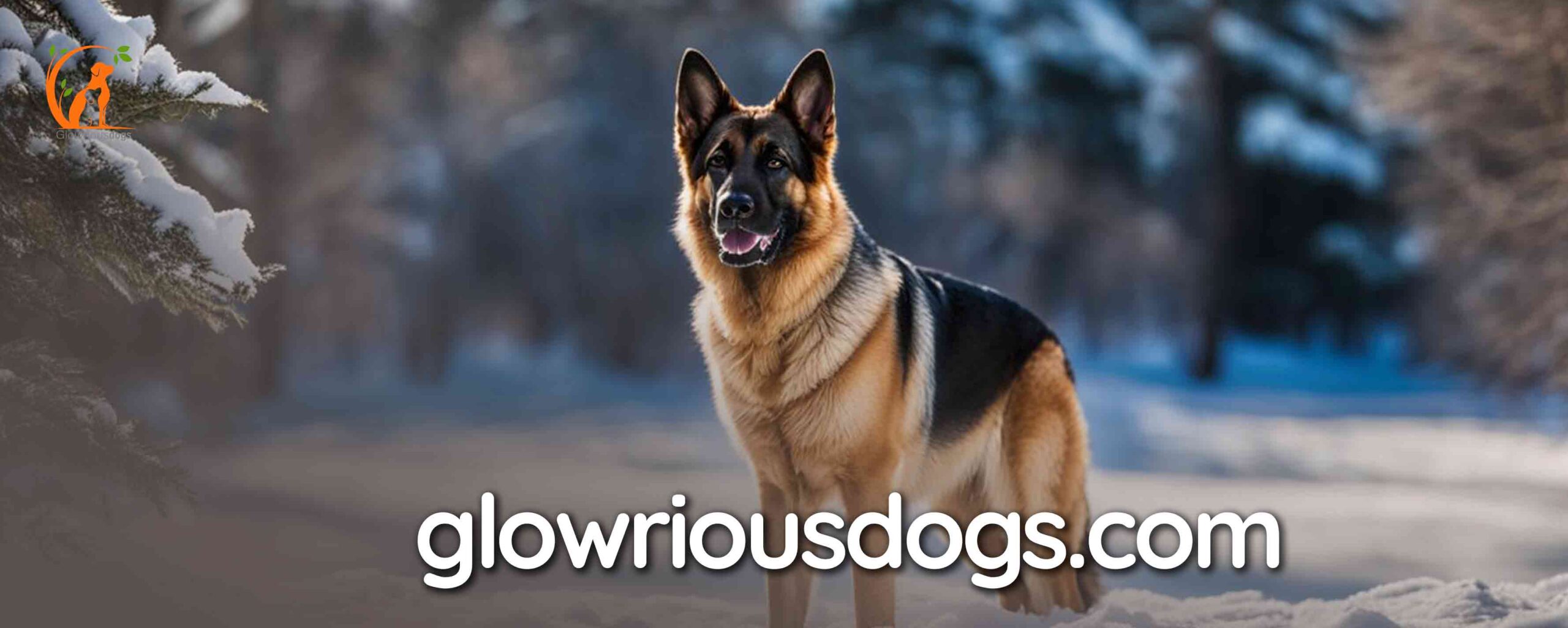German Shepherds can handle cold temperatures up to -20 degrees Celsius without experiencing significant issues. Strong and resilient, their thick double coats protect them from extreme cold, making them well-suited for colder climates.
Additionally, their unique physiology helps them conserve body heat, enabling them to withstand lower temperatures. However, it’s important to note that like all dogs, German Shepherds are susceptible to frostbite and hypothermia if exposed to prolonged cold conditions without proper shelter or protection.
Providing them with suitable shelter, protective clothing, and limiting their time spent outside in freezing temperatures is essential to keep them safe and comfortable during cold weather.
The Ideal Temperature Range For German Shepherds
German Shepherds can handle cold temperatures, but it’s important to know their ideal range. They are comfortable between 20-70°F, but extreme cold below 20°F can pose risks to their health. Proper shelter, insulation, and appropriate clothing can help protect them during chilly weather.
German Shepherds are known for their resilience and adaptability to various weather conditions. However, even these sturdy dogs have their limits when it comes to cold temperatures. It’s crucial for owners to understand the ideal temperature range for German Shepherds to ensure their furry companions’ well-being.
Let’s explore the factors that affect a German Shepherd’s tolerance to cold, the role of their coat and insulation, the optimal temperature for them, and the signs of discomfort or hypothermia to watch out for.
Factors That Affect A German Shepherd’S Tolerance To Cold:
- Age: Puppies and senior German Shepherds are more susceptible to the cold than adult dogs.
- Health: Underlying health conditions, such as arthritis or a weakened immune system, can impact their ability to withstand cold weather.
- Activity level: Highly active dogs generate more body heat, making it easier for them to tolerate cooler temperatures.
- Acclimatization: German Shepherds that live in colder climates or are gradually exposed to lower temperatures can develop better tolerance over time.
Understanding German Shepherd’S Coat And Insulation:
- Double coat: German Shepherds boast a thick double coat consisting of a dense undercoat and a coarse outer coat. This coat provides insulation and protection from cold weather.
- Water-repellent: Their outer coat has a water-resistant quality, allowing them to stay dry in wet conditions, which helps prevent rapid heat loss.
- Shedding: German Shepherds shed their undercoat seasonally, adapting to temperature changes. However, it’s important to note that shaving their coat can interfere with their natural insulation.
Optimal Temperature For German Shepherds:
- Range: German Shepherds are most comfortable in temperatures between 50°F and 80°F (10°C – 27°C).
- Precautions in extreme cold: When the temperature drops below freezing, it’s essential to take extra precautions to keep your German Shepherd safe, including providing proper shelter, limiting outdoor time, and considering protective clothing like jackets or boots as needed.
Signs Of Discomfort Or Hypothermia In German Shepherds:
- Shivering: If your German Shepherd shows persistent shivering, it may indicate that they are feeling cold and trying to generate heat.
- Lethargy: Extreme cold weather can cause dogs to become lethargic and less active than usual.
- Pale or gray gums: Cold temperatures can restrict blood circulation, leading to pale or gray gums in German Shepherds.
- Frostbite: Prolonged exposure to freezing temperatures can result in frostbite, causing the affected areas to become pale, swollen, and painful.
Remember, being aware of their comfort and well-being is crucial, especially when temperatures drop. By understanding the factors that affect their tolerance to the cold and knowing the signs of discomfort or hypothermia, you can ensure your German Shepherd stays happy and healthy even in chilly weather.
German Shepherd’S Natural Adaptability To Cold Climates
German Shepherds possess a natural adaptability to cold climates, making them well-suited for chilly environments. Their dense, double coat and robust build enable them to handle cold temperatures without issues.
German Shepherds’ Natural Adaptability To Cold Climates
German Shepherds are renowned for their versatility and adaptability, and this extends to their ability to thrive in cold climates. Their ancestral origins and evolutionary adaptations equip them with unique characteristics that enable them to navigate and endure harsh weather conditions.
Additionally, their physiology assists in regulating body temperature, ensuring their comfort and well-being even in extremely cold environments.
German Shepherds’ Ancestral Origins In Cold Climates
German Shepherds hail from Germany, where they were originally bred to be working dogs capable of withstanding the country’s frigid winters. Their predecessors, the herding dogs of the German countryside, laid the foundation for the breed we know today. These ancestral dogs were exposed to the cold and developed inherent resilience to endure low temperatures over extended periods.
Evolutionary Adaptations For Cold Weather Survival
Over time, German Shepherds have developed numerous evolutionary adaptations to effectively navigate and survive in cold climates. Here are some notable ones:
- Dense double coat: German Shepherds possess a thick, double-layered coat consisting of a coarse outer layer and a soft undercoat. This unique coat structure provides insulation, trapping warm air close to their bodies and shielding them from the cold. The outer layer repels moisture, preventing it from reaching their skin.
- Waterproof coat: The outer layer of a German Shepherd’s coat contains oils that make it water-resistant. This feature enables them to stay dry even in damp or snowy conditions, protecting them from getting wet and chilled.
- Fur on paws: German Shepherds have longer fur between their paw pads, acting as a natural barrier against cold surfaces. This adaptation helps to insulate their paws and prevent frostbite when walking on icy terrain.
How Their Physiology Helps Regulate Body Temperature
German Shepherds possess a physiology that aids in maintaining their body temperature in cold climates. Here’s how they do it:
- Efficient metabolism: German Shepherds have a high metabolism, which generates ample body heat. This metabolic advantage enables them to stay warm in cold weather, as they can produce and retain heat more effectively.
- Limited extremity blood flow: To conserve body heat, German Shepherds restrict blood flow to their extremities, such as their ears and tail. By reducing blood circulation to these areas, they ensure that the majority of warmth is retained in their core.
- Muscular build: German Shepherds have a well-developed muscular build, which not only contributes to their strength but also helps generate body heat. Muscles produce heat when they are active, providing an additional source of warmth for these dogs in cold climates.
German Shepherds’ ancestral origins in cold climates, along with their evolutionary adaptations and physiological characteristics, make them exceptionally well-equipped to handle and thrive in chilly weather conditions. Their ability to withstand low temperatures and regulate body temperature ensures their comfort and enables them to continue functioning as versatile and adaptable working dogs.
Winter Essentials For German Shepherds
German Shepherds have a high tolerance for cold weather, but it’s still important to provide them with winter essentials like insulated dog houses, warm bedding, and protective clothing to keep them comfortable and safe during chilly temperatures.
German Shepherds are known for their loyalty, intelligence, and endurance. These magnificent dogs are built to withstand various weather conditions, including the bitter cold of winter. However, just like humans, German Shepherds also need some extra protection to ensure their comfort and well-being during the winter months.
In this blog post, we will explore some essential winter gear for German Shepherds to keep them warm, cozy, and protected in icy temperatures.
Choosing The Right Outdoor Gear For Cold Weather:
- Insulated Dog Coats: These coats are designed to provide an extra layer of insulation and protection against the cold. Look for coats that are waterproof and windproof to shield your German Shepherd from the elements.
- Booties or Paw Protectors: The cold ground and icy surfaces can be harsh on your dog’s paws. Investing in booties or paw protectors can help prevent frostbite and injuries. Ensure they are comfortable and have good traction to prevent slips on slippery surfaces.
- Reflective Gear: Winter days are shorter, and darkness falls earlier. Opt for reflective gear such as a harness or collar to improve visibility during walks or outdoor activities, keeping your German Shepherd safe.
Insulated Dog Houses And Bedding Options:
- Insulated Dog Houses: If your German Shepherd spends a significant amount of time outdoors, providing an insulated dog house is crucial. Look for houses made with insulating materials to maintain a warm and comfortable environment for your furry friend.
- Heated Beds and Blankets: To ensure maximum warmth and comfort during cold nights, invest in a heated bed or blanket for your German Shepherd. These products provide extra warmth and prevent your dog from getting too chilly while sleeping.
Protective Clothing For Extreme Cold Conditions:
- Extreme Cold Weather Jackets: If you live in an area with severe winters or plan to take your German Shepherd on outdoor adventures in frigid conditions, consider investing in an extreme cold weather jacket. These jackets are specifically designed to provide ultimate protection against extreme temperatures.
- Dog Boots with Traction for Ice: In icy or snowy conditions, providing your German Shepherd with boots that have excellent traction is essential. High-quality boots will ensure your dog stays safe and secure while walking on slippery surfaces.
Remember, while these winter essentials can help keep your German Shepherd comfortable and protected in cold weather, it’s essential to monitor their behavior and well-being regularly. If you notice any signs of discomfort or distress, consult with a veterinarian for further guidance.
So, gear up your German Shepherd this winter for enjoyable and safe outdoor adventures!
Essential Measures To Keep German Shepherds Warm
Keep your German Shepherd warm in cold weather with these essential measures. German Shepherds can handle a certain level of cold, but it’s important to provide them with proper shelter, blankets, and indoor areas to keep them comfortable and safe.
German Shepherds are known for their intelligence, loyalty, and boundless energy. However, just like humans, they need extra care during colder months to stay warm and healthy. Here are some essential measures you can take to keep your German Shepherd warm:
Maintaining Proper Nutrition For Energy And Warmth
A well-balanced diet is crucial for keeping German Shepherds warm during colder months. Here’s how you can ensure they receive the right nutrition:
- Feed them high-quality dog food rich in proteins, healthy fats, and essential nutrients for energy.
- Consider incorporating warm foods like cooked lean meats and vegetables into their diet.
- Add fish oil or omega-3 supplements to their meals, as it can help promote a healthy coat and enhance their ability to retain heat.
- Consult your veterinarian to determine the ideal calorie intake for your German Shepherd, as their needs may vary based on factors like age, weight, and activity level.
Regular Exercise To Keep Them Active And Warm
Exercise is not only important for your German Shepherd’s physical well-being but also for keeping them warm. Here’s how you can ensure they get enough exercise during colder months:
- Schedule regular playtime and walks to keep their body temperature up.
- Engage them in mental stimulation activities like puzzle toys to keep them active indoors when outdoor activities are limited.
- Consider enrolling them in indoor dog training classes or agility courses to provide both mental and physical exercise.
Providing Enough Fresh Water And Hydration
Proper hydration is vital for maintaining your German Shepherd’s body temperature. Here’s how you can ensure they stay hydrated during colder months:
- Never let water freeze; make sure to provide clean and unfrozen water at all times.
- Consider using heated water bowls or adding a small amount of warm water to their drinking bowl to entice them to drink when it’s chilly outside.
- Monitor their water intake and encourage regular drinking to prevent dehydration, as it can impair their ability to maintain body heat.
By following these essential measures, you can help your German Shepherd stay warm and comfortable during colder months. Remember, their well-being is essential, and taking these simple steps will ensure they can face the cold weather with a wagging tail.
Creating A Safe And Warm Environment Indoors
German Shepherds can handle cold temperatures, but it’s important to create a safe and warm environment indoors. Providing adequate shelter, insulation, and comfortable bedding can help keep them comfortable during the winter months.
Setting Up A Warm And Cozy Living Space
A comfortable and inviting living space is essential for German Shepherds, especially during colder months. Here are some important considerations when creating a safe and warm environment indoors:
- Temperature control: Maintain a consistent temperature inside your home to ensure your German Shepherd’s comfort. Ideally, keep the temperature between 68 to 75 degrees Fahrenheit (20 to 24 degrees Celsius).
- Draft prevention: Inspect windows and doors for any drafts that could make the space colder. Sealing gaps and using draft stoppers can help minimize the entry of cold air.
- Adequate bedding: Provide your German Shepherd with a cozy bed, preferably raised off the floor, to keep them away from any cold surfaces. Consider using dog beds with memory foam or thermal properties for added warmth and comfort.
- Soft blankets: Place warm, soft blankets in your dog’s sleeping area to provide insulation and extra warmth during colder periods.
- Elevated feeding and water bowls: Elevating your dog’s food and water bowls off the floor can prevent them from getting too cold, especially if your home has a colder floor surface.
- Proper shelter: If your German Shepherd spends time outdoors, ensure they have access to a well-insulated and weatherproof shelter that protects them from rain, wind, and extreme cold. The shelter should be large enough for them to stand, turn, and comfortably lie down.
Proper Heating And Insulation Techniques
Maintaining a warm environment indoors requires effective heating and insulation techniques. Here are some tips to help keep your German Shepherd cozy during colder seasons:
- Use space heaters: Strategically place space heaters in rooms where your German Shepherd spends the most time. Make sure the heaters are safe, well-maintained, and not accessible to your dog to prevent accidents.
- Heating mats: Consider using heating mats designed for pets to provide localized warmth. These mats are safe and often have adjustable temperature settings.
- Insulation: Properly insulate your home to prevent heat loss. Insulated walls, floors, and ceilings help retain warmth and reduce energy costs.
- Weatherstripping: Apply weatherstripping to windows and doors to seal any gaps and prevent cold drafts from entering. This will also improve overall insulation in your home.
- Use rugs and carpets: Adding rugs and carpets to your home helps insulate the floors, making them less cold and more comfortable for your German Shepherd to walk and lie on.
Importance Of Indoor Stimulation And Mental Enrichment
While creating a warm and cozy living space is crucial, keeping your German Shepherd mentally stimulated indoors is equally important. Here are some ways to provide mental enrichment for your furry companion:
- Puzzle toys: Invest in interactive puzzle toys that require your German Shepherd to figure out how to access hidden treats or toys. This engages their mind and keeps them entertained.
- Training sessions: Regular training sessions not only strengthen the bond between you and your dog but also provide mental stimulation. Teach them new tricks or practice obedience commands to challenge their intellect.
- Scent games: Hide treats or toys around the house and encourage your German Shepherd to use their nose to find them. This taps into their natural scenting abilities and provides mental exercise.
- Rotating toys: Instead of leaving all toys out at once, rotate them periodically to keep your dog interested and prevent boredom. This helps them engage more with their toys and prevents the toys from losing their appeal.
- Playdates: Organize playdates with other friendly dogs to provide social interaction and mental stimulation. This allows your German Shepherd to engage in active play, which is essential for their overall well-being.
Remember, creating a safe, warm, and mentally stimulating indoor environment is beneficial not only for your German Shepherd’s physical health but also for their mental and emotional well-being. By following these tips, you can provide your furry friend with a comfortable and enjoyable indoor space, even during colder months.
Recognizing Early Signs Of Hypothermia
German Shepherds can handle cold temperatures, but it is important to recognize the early signs of hypothermia. Watch for shivering, lethargy, and difficulty walking as indicators that your dog may be experiencing this dangerous condition.
German Shepherds are hardy and resilient dogs, but they too are susceptible to the dangers of hypothermia. As responsible pet owners, it is crucial to understand the early signs of hypothermia and take prompt action to prevent any serious consequences.
In this section, we will delve into the dangers of hypothermia in dogs, discuss the signs and symptoms to look out for, and provide quick action steps to treat hypothermia in German Shepherds.
Understanding The Dangers Of Hypothermia In Dogs:
- Dogs, including German Shepherds, rely on their body’s ability to regulate their internal temperature. However, when exposed to cold temperatures for extended periods or if their core body temperature drops drastically, they may experience hypothermia.
- Hypothermia occurs when a dog’s internal body temperature falls below 99°F (37.2°C).
- Cold weather, damp conditions, and prolonged exposure to cold water are common factors that contribute to hypothermia in German Shepherds.
- It’s vital to remember that hypothermia can be life-threatening for dogs if not recognized and treated promptly.
Signs And Symptoms To Look Out For:
- Shivering: One of the first signs of hypothermia in a German Shepherd is shivering. It is the body’s natural response to generate heat.
- Cold ears and extremities: If your German Shepherd’s ears, paws, or tail feel unusually cold to the touch, it may indicate a drop in body temperature.
- Lethargy and weakness: When hypothermic, German Shepherds may exhibit signs of weakness, fatigue, and reduced energy levels.
- Pale or blueish gums: Hypothermia can affect blood circulation, resulting in pale or bluish gums in German Shepherds.
- Shallow breathing: A sluggish respiratory rate, with shallow and slow breaths, is another symptom of hypothermia.
- Mental confusion or disorientation: German Shepherds experiencing hypothermia may exhibit signs of confusion, disorientation, or difficulty in coordinating their movements.
Quick Action Steps To Treat Hypothermia In German Shepherds:
- Move the dog to a warm environment: Get your German Shepherd into a warm and dry place as soon as possible.
- Use blankets or towels: Wrap your dog in warm blankets or towels, focusing on the head, neck, and torso. Avoid using direct heat sources such as heating pads or hairdryers, as they can cause burns.
- Offer warm fluids: If your dog can swallow, provide warm fluids such as sugar water or warm broth to help raise their internal body temperature.
- Rub their body: Gently rub your German Shepherd’s body to stimulate blood circulation and help generate heat.
- Monitor their temperature: If you have a rectal thermometer available, carefully check your dog’s temperature every few minutes. Once their temperature reaches 100°F (37.8°C), you can gradually remove the blankets and continue monitoring.
- Seek veterinary assistance: Even if your German Shepherd begins to recover, it is crucial to contact your veterinarian for professional guidance and further evaluation of their condition.
By understanding the dangers of hypothermia, recognizing the signs and symptoms, and taking quick action, you can ensure the well-being and safety of your German Shepherd in cold weather conditions. Remember, prevention is always better than cure, so keep a watchful eye on your furry friend and provide them with the necessary warmth and shelter during chilly periods.
Precautions For Cold Weather Activities
German Shepherds are well-suited for colder weather due to their double coat, but precautions should still be taken. Ensure they have shelter and limit their time outside to prevent exposure to extreme conditions. Monitor their behavior for signs of discomfort or cold-related ailments.
Outdoor Activities Suited For Colder Climates:
- Taking your German Shepherd for a walk or hike: Dogs love exploring the great outdoors, and German Shepherds are no exception. Take them for a brisk walk or hike in colder weather and let them enjoy the fresh air and exercise.
- Playing fetch or tug-of-war: Engaging in active play with your German Shepherd can help keep them warm during cold weather. Play a game of fetch with a ball or engage in a friendly tug-of-war session.
- Agility training: German Shepherds are known for their agility and intelligence. Set up an agility course in your backyard or find an indoor facility where you can train your German Shepherd, helping them stay active and mentally stimulated.
Safety Precautions For Snow And Ice:
- Dress your German Shepherd appropriately: Just like humans, dogs can benefit from wearing proper attire in cold weather. Consider getting a dog sweater or jacket to keep your German Shepherd warm during walks in the snow or ice.
- Protect their paws: Snow and ice can be tough on your dog’s paws. Consider using protective booties to prevent ice balls from forming between their toes and to protect their paw pads from contact with cold surfaces.
- Be mindful of their limits: While German Shepherds are generally able to handle colder weather, it’s important to pay attention to their behavior. If you notice signs of discomfort, such as shivering or lifting their paws frequently, it may be time to head indoors.
Protective Options For German Shepherds’ Paws:
- Paw wax: Applying paw wax or balm to your German Shepherd’s paws can help protect them from the cold, harsh surfaces. It acts as a barrier between their paws and the elements, preventing dryness and cracking.
- Moisturizing paw pad creams: Just like human skin, a dog’s paw pads can become dry and cracked in cold weather. Applying a moisturizing paw pad cream can help keep their paws soft and supple.
- Regular paw checks: It’s important to regularly check your German Shepherd’s paws for any signs of injury or damage. Keep their nails trimmed to prevent discomfort while walking on icy or slippery surfaces.
Remember, while German Shepherds are generally suited for colder climates, it’s essential to take precautions and keep an eye on their well-being. By following the tips mentioned above, you can ensure your furry friend stays safe and comfortable during cold weather activities.
Supporting Your German Shepherd During Winter Months
German Shepherds can handle cold weather, but it’s important to support them during the winter months. Provide them with proper shelter, warm bedding, and protective clothing to keep them safe and comfortable in low temperatures.
As the temperatures drop and snowflakes start to fall, it’s important to ensure your German Shepherd stays warm and comfortable during the winter months. Here are some essential tips to support your furry friend throughout the cold season.
Grooming Practices For Winter Coat Maintenance:
- Regular brushing: Brushing your German Shepherd’s coat is crucial during winter. It helps in removing loose and dead hair, improving air circulation and insulation.
- Bathing: Limit bathing your German Shepherd to avoid stripping away the natural oils that provide insulation and moisture retention.
- Paw care: Check your dog’s paws regularly for ice, snow, and salt buildup. Wipe their paws with a warm, damp cloth after walks to prevent irritation.
- Moisturizing: Consider using pet-safe moisturizers or balms on your dog’s paws, nose, and ear tips to protect them from dryness and cracking.
- Coat protection: Investing in a well-fitted winter coat or sweater can help your German Shepherd stay warm during outdoor activities. Ensure it covers the body adequately, especially the chest and belly.
Special Considerations For Older Or Medically Fragile German Shepherds:
- Adequate shelter: Ensure your German Shepherd has access to a warm and insulated space indoors. Provide cozy bedding away from drafts and cold floors.
- Limited outdoor exposure: Older or medically fragile German Shepherds may have a harder time regulating body temperature. Limit their time spent outside, especially during extreme cold weather conditions.
- Supplements: Consult with your veterinarian about adding supplements, such as omega-3 fatty acids, to support joint health and overall immunity during the winter months.
- Dietary adjustments: Adjust your German Shepherd’s diet as needed to maintain a healthy weight and support their immune system. High-quality and nutrient-dense food can help keep them strong and energetic.
- Increased exercise indoors: Engage your German Shepherd in indoor activities and exercise to keep them mentally and physically stimulated, as outdoor exercise may be limited. Puzzle toys and interactive games are great options.
- Additional warmth: Consider providing your older or medically fragile German Shepherd with heated bedding or blankets to keep them cozy and comfortable.
Regular Veterinary Check-Ups For Overall Health Assessment:
- Schedule regular veterinary check-ups to ensure your German Shepherd’s overall health and well-being during the winter months.
- Discuss any concerns or changes in behavior with your veterinarian to address potential health issues promptly.
- Vaccinations: Keep your German Shepherd’s vaccinations up to date to protect them from infectious diseases that may arise during colder months.
- Preventive treatments: Follow your veterinarian’s recommendations for flea, tick, and heartworm preventive treatments, as these pests can still pose a threat during winter.
By following these guidelines, you can ensure that your German Shepherd stays well-cared for and comfortable throughout the chilly winter months. Remember, your furry friend depends on you to provide the necessary support and protection during this season.
Conclusion
German Shepherds are a hardy breed that can handle cold weather to an extent. While they have a dense double coat that provides insulation, it is important to take precautions when the temperatures drop. Providing them with a warm and dry shelter, suitable clothing, and adequate hydration is crucial.
Their tolerance to cold also depends on factors such as age, health condition, and individual differences. It is essential to monitor their behavior and physical responses to ensure their comfort and well-being during colder months. Regular exercise and mental stimulation are important, even when it’s chilly outside.
By being mindful of their needs and taking the necessary measures, you can ensure that your German Shepherd remains happy and healthy in colder climates. So, prepare well, keep an eye on your furry friend, and make the most of the time you spend together, regardless of the weather!
Frequently Asked Questions For How Cold Can German Shepherds Handle
Can A German Shepherd Sleep Outside In The Cold?
Yes, a German Shepherd can sleep outside in the cold as long as they have proper shelter and insulation to keep them warm.
Can I Walk My German Shepherd In 20 Degree Weather?
Yes, it is safe to walk your German Shepherd in 20-degree weather.
Do German Shepherds Need Jackets In Winter?
German Shepherds may need jackets in winter to protect them from the cold weather.
How Cold Can German Shepherds Handle?
German Shepherds can handle cold temperatures as low as 20 degrees Fahrenheit. However, it’s important to keep in mind that every dog is different and may have different tolerances for cold weather. It’s always best to provide them with appropriate shelter and clothing during extreme cold conditions.











